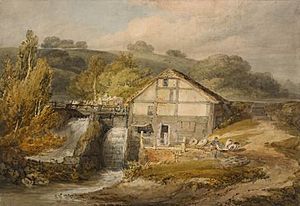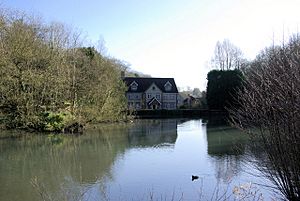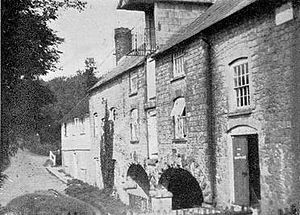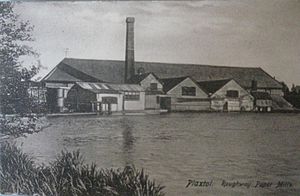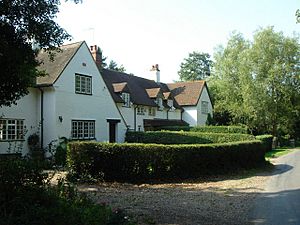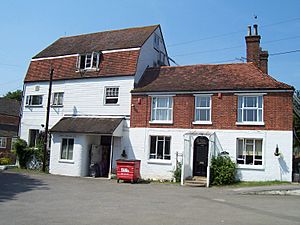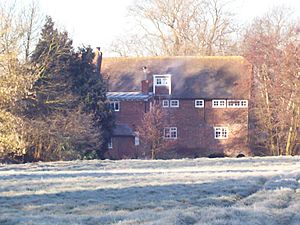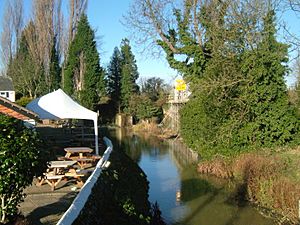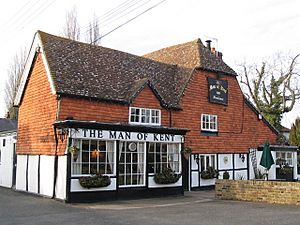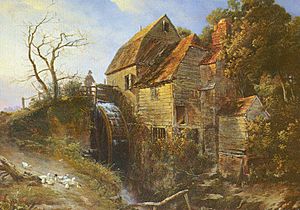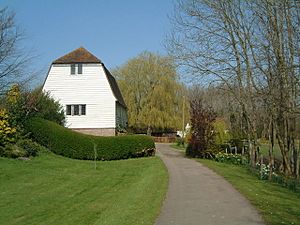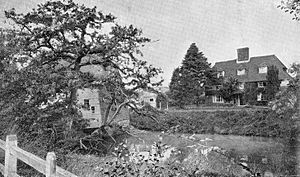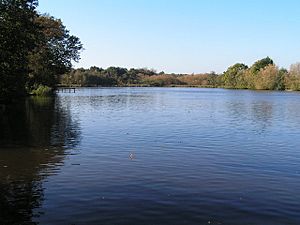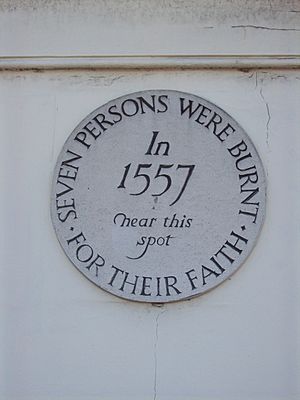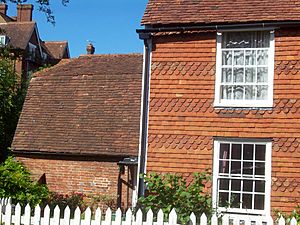Medway watermills (middle tributaries) facts for kids
The Medway River and its smaller streams have been used for over 1,150 years to power different machines. More than 200 places along these waterways are known to have used water power.
People used this power for many things, like grinding corn, making paper, working with iron, pumping water, making gunpowder, getting oil from vegetables, and even making electricity. Today, only one watermill still works for its original purpose. Most of the others have been changed into homes, restaurants, museums, or even a wedding place. Some are just old ruins, while many have disappeared completely.
This article will tell you about the watermills on the streams that flow into the Medway River between Penshurst and Yalding. We'll talk about the streams in the order they join the Medway, and the mills along each stream from its start to where it meets the main river.
Contents
- The Southborough Bourne Stream
- Tudeley Brook Stream
- Pen Stream
- River Bourne
- River Teise
- Tributaries of the Teise
- River Bewl (Teise tributary)
- River Beult
- Angley Brook (Beult tributary)
- Hammer Stream (Beult tributary)
- Crane Brook (Hammer Stream tributary)
- Stream at Chart Sutton (Beult tributary)
- Images for kids
The Southborough Bourne Stream
This stream starts in Colebrook Park, Pembury, and flows into the Medway River near Tonbridge. It used to be called the Calverley Stream and powered three watermills.
Vauxhall Furnace, Southborough
This old iron furnace was near Mote Farm. It was used to melt iron, which was then shaped at a forge further downstream. It was working as early as 1552! Later, in 1771, a gunpowder mill was built here. By 1933, only a few parts of the waterwheel remained. The dam that held back the water was about 60 meters (66 yards) long and 2.5 meters (8 feet) high.
Brook Mill, Southborough
This place was first built as a forge in 1553. It worked with Vauxhall Furnace for many years. It became a gunpowder mill from 1771 until at least 1801. Later, a corn mill was built here in 1845 and kept working until 1942.
Bourne Mill, Southborough
This mill is marked by Bournemill Farm. Experts believe it was another iron furnace.
Priory Mill, Tonbridge
This mill once belonged to Tonbridge Priory, an old religious house. It was not used by the 1930s, and today, nothing is left to show where it stood. It had an overshot waterwheel, which means the water flowed over the top of the wheel to make it turn.
Tudeley Brook Stream
This stream starts at Colts Hill and flows into the Medway River. It powered two watermills.
Keyes Mill, Pembury
This watermill had a wooden overshot waterwheel. It was still standing around 1796, when the famous artist J. M. W. Turner painted it. The mill was still working in 1885.
Spring Grove Mill, Pembury
This mill was located in Redwings Lane. In the 1200s, it was given to Bayham Abbey, an old monastery.
Pen Stream
The Pen Stream starts west of Dene Park in Tonbridge and joins the Medway River at Hadlow Stair. It powered one watermill.
Mill at Hadlow Stair
This watermill might have been around in 1460, when a survey of Hadlow was done. The Mill House and the Mill Ditch (the channel for water) were mentioned back then.
River Bourne
The River Bourne flows into the Medway River at East Peckham. This river powered many watermills along its 10-mile (16 km) length.
Basted Paper Mill, Platt
This paper mill was working in 1716. The mill pond was very large, about 175 yards (160 meters) long. The mill burned down in 1917 but was rebuilt and used steam power until 1960. It finally closed after being damaged by floods in 1968. This mill even supplied paper used for postage stamps!
Winfield Mill, Plaxtol
Winfield Mill was a corn mill built in 1836. It was made of a type of stone called ragstone. The mill was still standing in 1930 but was a ruin by 1940. It had an overshot waterwheel, which was built in 1874. Some of the grinding stones are still there today.
Roughway Paper Mill, Plaxtol
This mill was built around 1807 and used both steam and water power. It made paper that was used for printing postage stamps for other countries. There used to be a very tall chimney here that was a local landmark, but it was taken down in 1997 after a fire.
Hamptons Paper Mill, West Peckham
This paper mill was built in 1740 and was active until the 1880s. It was about 75 feet (23 meters) long and 24 feet (7.3 meters) wide. Only small parts of its foundations remain today. It was probably demolished around 1890, but the old mill cottages still stand across the road.
Oxonhoath Mill, West Peckham
This site has been used since 1259! Over time, it has been both a fulling mill (used to thicken cloth) and a corn mill. The mill building was still standing in 1930, but its machinery had been removed. Today, only parts of the lower walls are left.
Bourne Mill, Hadlow
This mill might have been mentioned in the Domesday Book, a famous survey from 1086. The mill building is still standing and once had a large waterwheel on the outside. It worked until 1947. Today, a clothing factory operates there.
Goldhill Mill, Golden Green
This mill is a very old site, possibly dating back to the Domesday Book. It's a listed building, meaning it's protected because of its history. It's the only mill on the Bourne River that still has most of its original machinery! It has an iron waterwheel inside. The mill last ground corn around 1920. In the early to mid-1900s, it even generated electricity. Now, the buildings around the mill have been turned into holiday cottages.
Little Mill, East Peckham
This mill building is still standing today. Part of it has been turned into a house, and part has been taken down. It had a breastshot waterwheel, where water hits the wheel around its middle.
River Teise
The River Teise flows into the Medway River at Yalding. This river and its smaller streams powered many watermills.
Standings Mill, Tunbridge Wells
This was a corn mill with an overshot waterwheel. A painting of this mill from the 1800s can be seen in the Tunbridge Wells Museum & Art Gallery.
Bayham Abbey Forge
This forge was working in 1520 and was still in use in 1667. The pond that powered it still exists.
Gloucester Furnace, Lamberhurst
This furnace was built in 1695 and made 200 tons of iron in 1717! It stopped making iron around 1787.
Hoadly Forge, Lamberhurst
Hoadly Forge was built in 1548. Interestingly, the railings around St. Paul's Cathedral in London were made here!
Furnace Mill, Lamberhurst
This was a corn mill. The building is still standing today, but it's been turned into a home and doesn't have its machinery anymore, except for the sack hoist (used to lift sacks of grain). The building dates back to around 1812.
Hope Mill, Goudhurst
This corn mill has now been converted into a house. It used to work with two waterwheels, both breastshot. One was older and closer to the building, and a newer, larger one was set a bit further away.
Marden Mill, Marden
Marden Mill was a corn mill. It was a small, three-story wooden building. It was powered by an overshot waterwheel. The Hammond family ran this mill for many years. It stopped working in 1892 and was taken down in 1912.
Tributaries of the Teise
Benhall Mill, Frant
This corn mill was built on the site of an even older iron furnace. The mill itself was working until at least 1887. The remains of the mill were taken down in 1964.
Brookland Forge, Frant
This forge was sold in 1521. There's evidence that it had an overshot waterwheel. The dam was about 65 meters (71 yards) long.
Verredge Forge, Frant
This forge was also owned by the Barham family. It was last mentioned in 1642. The dam for this forge was quite large, about 120 meters (131 yards) long and 3 meters (10 feet) high.
Bartley Mill, Frant
Bartley Mill is located on the Winn Stream. It was last used for business in the 1900s and was restored in 1990. You can visit this mill by making an appointment.
Bedgebury Furnace, Goudhurst
This furnace was used to make iron. It was working in 1574 and was even repaired and used again during the Peninsular War (early 1800s) because there was a high demand for iron for the military. However, it eventually stopped making iron because it was too expensive to transport goods from this location. The site still has a very large dam, about 130 meters (427 feet) long, that used to hold the water for the furnace.
Brenchley Furnace, Horsmonden
This is a very old site. The Furnace Pond is still there today and covers about 30 acres (12 hectares)! The dam is about 140 yards (128 meters) long. This furnace was first mentioned in 1574 and was known for making guns. About 200 men worked here in 1613.
River Bewl (Teise tributary)
Dunsters Mill, Ticehurst
This watermill site is now under Bewl Water, a large reservoir. It was a very unusual mill because its millstones were driven from above, which is more common in windmills. The 14th-century Mill House was moved and rebuilt in a different location when Bewl Water was created.
Chingley Forge, Goudhurst
The site of this old forge is now covered by the dam of Bewl Water. It was built between 1574 and 1589. It was working in 1717 and produced 46 tons of iron that year.
Chingley Furnace, Goudhurst
The site of this old blast furnace is also now covered by the dam of Bewl Water. It was built between 1558 and 1565. This forge was powered by an undershot waterwheel, where water flows under the wheel to make it turn.
River Beult
The River Beult flows into the Medway River at Yalding. This river and its smaller streams powered many watermills.
Cheveney Mill, Hunton
This was a corn mill that was later changed to make electricity around 1900. Its waterwheel was replaced by a water turbine. During World War II, Italian prisoners of war were housed in the mill building. The building is still standing today and has been turned into a house.
Angley Brook (Beult tributary)
This stream starts at Angley Woods and flows into the Beult River. It powered several mills.
Hartridge Mill, Cranbrook
This was a corn mill. The mill building was still standing in 1974, but it had no machinery inside. It probably had a breastshot waterwheel.
Maplehurst Mill, Frittenden
This is a very old corn mill site that still has most of its machinery! It has a cast iron overshot waterwheel that drives three pairs of millstones. A sad part of its history: in 1557, the miller, William Allin, and his wife, Katherine, were burned at the stake in Maidstone because they were Protestants. They had helped the poor, sold corn cheaply, and read religious texts to people.
The oldest part of the mill dates back to 1756. The mill was expanded around 1890 when a steam engine was added. The mill worked until the winter of 1947-1948, when its machinery was damaged by ice.
Hammer Stream (Beult tributary)
The Hammer Stream powered watermills at:
Hammer Mill, Biddenden
This was the most easterly iron furnace in the Weald region. It was replaced by a corn mill in the mid-1600s. The Hammer Pond used to be very large, covering about 30 acres (12 hectares).
Hammer Mill (corn), Biddenden
This corn mill stands about 200 yards (183 meters) southwest of the old furnace site. The brick mill building is three stories high. It had an overshot waterwheel that drove four pairs of millstones at one time. The mill last worked for business in 1928.
Crane Brook (Hammer Stream tributary)
The Crane Brook starts at Hartley and powered several mills before joining the Hammer Stream.
Sissinghurst Mill
The site of this mill is now covered by Lake Chad. In the early 1600s, this was a corn mill.
Hatmill, Cranbrook
In the late 1700s, John Tooth built a small factory behind his house in Cranbrook where he made hats. It was powered by a small waterwheel. The building is still standing today and is a private house.
Stream at Chart Sutton (Beult tributary)
This stream starts at Chart Sutton and flows into the Beult River. It powered one watermill.
Chart Mill, Chart Sutton
This mill is a timber-framed building on a brick base. The waterwheel, which was very large (about 24 feet or 7.3 meters in diameter), was removed during World War Two. The lower floor of the mill was filled with concrete when it was converted, and the upper floors are now used as an office.
Images for kids


